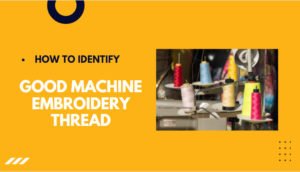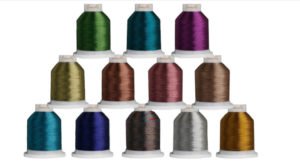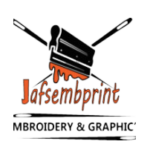Table of Contents
Best Embroidery Machine Thread
If you are new to embroidery and do not have any ideas as there are lots of thread brands and you do not know, what embroidery machine thread brand you have to choose. When I initially started embroidering, I had a lot of questions as well.
- What is the best embroidery machine thread, for example?
- What kind of thread should be used in the bobbin?
- What thread material and weight should I use?
There were a lot of things I needed to figure out.
I’ve determined which threads my embroidery machine prefers thanks to years experienced embroidery machine operator team. Not all machine embroidery threads are made equal, every thread has its own qualities.
So, how do you decide which embroidery thread is ideal for your machine? Let’s talk about machine embroidery thread varieties, weights, and finishes, as well as how to choose the best machine embroidery thread for your next project!

How to Identify Good Machine Embroidery Thread
Not every thread you see online or at a store is suitable for use in an embroidery machine. For that matter, neither is the 30-year-old embroidery thread I inherited from my grandmother and once attempted to use.
Threads can break, shred, or fray if you use a low-quality or unsuitable thread. This isn’t enjoyable, especially if you’re embroidering anything valuable or sensitive!
So, what should you be on the lookout for?
Run your fingertips along a tiny section of the thread to make sure it’s smooth and consistent, with no lumps, bumps, or visible fibers. When the embroidery machine is sewing at top speed, smooth thread reduces friction at the eye of the needle.
To evaluate machine embroidery thread strength, hold two sides of the thread between your thumbs and forefingers and tug. Toss the thread if it breaks without any effort. Your machine will wreak havoc on it!
Thread Weight in Embroidery Explained
Threads are classified by their weight (wt), which is a measurement of thread thickness.
The narrower the thread, the higher the weight number will be. As a result, a 60 wt thread is thinner than a 40 wt thread, while a 30 wt thread is thicker than the latter.
Thicker threads are more suited to heavyweight fabrics, offering greater coverage for those fill-stitch patterns. Finer threads perform well on delicate textiles, while thicker threads are better suited to heavyweight fabrics, providing better coverage for those fill-stitch designs.
Choosing the right thread weight is crucial to the completed product’s success!
Machine embroidery patterns are digitized using 40 wt thread unless otherwise noted (the most common). As a result, until you understand how modifications influence pattern stitch outs, use a 40 wt thread.
Changes in thread weight may also need a change in needle size.
Finally, before choosing an unusual thread thickness, double-check your machine’s manual to be sure it can handle it. Brother embroidery machine, for example, will not work with 12 wt thread in the top thread.
What is the best embroidery Machine thread brand?
To this question, there is no best solution!
You’ll get at least five different replies if you ask ten embroidery lovers about their preferred threads.
There’s the rayon vs. polyester dispute, for starters. Then there are certain machines that advocate certain brands, and some machines that stitch better with certain brands, so it’s a matter of trial and error. The intended purpose of embroidered products, as well as the cost (embroidery supplies are not cheap! ), play a role.
Sulky, Gutermann, Coats and Clark, Madeira, Isacord, Floriani, Simthread, and Embroidex are some other thread brands that haven’t been mentioned yet.
You also don’t have to buy thread from the same manufacturer as your machine. The best embroidery thread for a Brother machine, for example, isn’t always Brother embroidery thread. In actuality, Brother embroidery thread isn’t particularly well-known!
Useful Embroidery Thread Hints
- Do not pull the thread out of the machine and back towards the spool while changing thread colors.
Instead, snip the thread and draw it down and out before inserting it into the thread guides. If you pull the thread the wrong way, you could irritate your tension discs.
- If you’re having problems with skipped stitches, threads breaking, or other stitching issues that aren’t clear, replace your needle. A dull, twisted, or nicked needle can cause chaos at times!
- There are two popular ways to wind threads: cross-wound and stacked.
Stacked threads are made up of parallel threads and are best used on vertical machine spools.
Cross-wound spools have a crisscross pattern and are more effective on horizontal machine spool holders. My machine doesn’t mind because we utilize all of our threads vertically.
Most Used Threads for Embroidery Machines
Polyester, rayon, and cotton are the three main types of embroidery thread to utilize as the top thread. Then there are a variety of specialist threads that, with a little more care, may be used on an embroidery machine. Before we go into bobbin thread possibilities, let’s talk about upper thread alternatives.

Rayon Embroidery Thread for Machines
Rayon embroidery thread is a longtime favorite among embroidery fans due to its beautiful, shiny, and reflecting shine.
It’s shinier than most other thread kinds, as well as stronger and more durable, and it comes in a wide selection of colors. Rayon thread is made of organic cellulose and is extremely soft to the touch.
Its popularity has waned over time, and polyester thread has taken its place. Why? Some rayon threads bleed when washed, don’t hold up well to bleaching, and fade with time and exposure to the sun.
When we originally our business and began seeking for the best embroidery thread, numerous vendors advised us to avoid rayon. We’ve been informed that rayon thread doesn’t hold up as well as it does in cooler, lower-humidity environments.
Polyester Embroidery Thread for Machines
Polyester embroidery thread is becoming increasingly popular as a result of its superior characteristics.
It has a lovely shine and brilliance, as well as a broad spectrum of colors. It’s also extremely tough and resistant to shredding due to friction when it passes through the needle’s eye. When stitching designs, polyester and rayon threads are frequently interchangeable. So, which is better: rayon or polyester?
Although rayon threads have a higher shine, polyester threads are often stronger, will not fade over time or in the sun, will not bleed in the washer, and can tolerate bleach. Polyester thread has proven to be the best embroidery thread for my Brother machine. It’s what was advised to me at first, it’s reasonable, and I’ve never had any issues with it.
Cotton Embroidery Thread for Machines
Cotton embroidery thread is the least common of the three primary types of thread. It is made from natural fibers and comes in the widest range of weights.
The most common thread weight for machine embroidery is 30 wt, however, there are thicker and thinner options available.
Unlike rayon or polyester embroidery threads, most cotton embroidery threads have a matte texture. This is useful if you want a more natural look, such as when embroidering lace. Cotton embroidery threads, on the other hand, are delicate due to their lack of flexibility. As a result, they are more prone to breaking than the varieties listed above.
They can also shrink (unlike polyester) when cleaned, fade in the sun, and cause your embroidery machine to fuzz up. When doing complicated designs.
Silk Embroidery Thread
Silk thread, which is also a natural fiber embroidery thread, is a particular form of a thread that is both robust and luxurious.
It’s pricey and difficult to come by, but it goes great with really delicate textiles like silk and satin!
Metallic Embroidery Thread
Internally, metallic machine embroidery threads contain a metal foil-wrapped core. Metallic threads from KingStar come highly recommended!
Metallic threads are notoriously difficult to embroider with, despite the fact that they provide a gleaming, wonderful end product.
At high speeds, they break readily, necessitating the use of a special needle and fine-tuned thread tension.
Machine Embroidery Thread that Glows in the Dark
Glow-in-the-dark thread is a fun addition to my thread stash, and I’ve had a lot of fun working with it!
Are you looking for a fun Halloween project?
Consider using a thread that glows in the dark!
This sort of embroidery thread also necessitates the use of a particular needle and might be difficult to set up.
It is available in a wide range of colors, although the majority of them are greenish-yellowish in color.
However, certain hues are more vibrant than others.
Embroidery Threads with Variegated Colors
Embroidery machine threads with variegated patterns are created from two or more colors in a random pattern.
Fibers such as rayon, polyester, cotton, and even silk are used to make them.
It’s easier to use variegated thread than it is to use other specialist embroidery machine threads, such as those annoying metallic.
Machine Embroidery Bobbin Thread
Unlike sewing, where the bobbin case and spool threads are the same, the bobbin thread for an embroidery machine is usually finer than the top thread.
Because the thread is less weight, the bulk of the embroidery thread is reduced, resulting in smoother top stitches and less stiff or puckered dense designs.
For embroidery machines, the ideal bobbin thread is 100% polyester 60 wt thread. A different weight may be required by some machines. The best thing to do is check your machine’s user manual to see what it needs.
If the back of the bobbin embroidery thread isn’t visible, you can use white thread.






